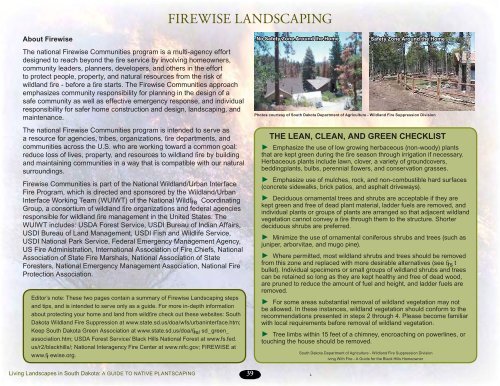Living Landscapes in South Dakota - Plant Materials Program - US ...
Living Landscapes in South Dakota - Plant Materials Program - US ...
Living Landscapes in South Dakota - Plant Materials Program - US ...
You also want an ePaper? Increase the reach of your titles
YUMPU automatically turns print PDFs into web optimized ePapers that Google loves.
About Firewise<br />
FIREWISE LANDSCAPING<br />
No Safety Zone Around the Home<br />
Safety Zone Around the Home<br />
The national Firewise Communities program is a multi-agency effort<br />
designed to reach beyond the fire service by <strong>in</strong>volv<strong>in</strong>g homeowners,<br />
community leaders, planners, developers, and others <strong>in</strong> the effort<br />
to protect people, property, and natural resources from the risk of<br />
wildland fire - before a fire starts. The Firewise Communities approach<br />
emphasizes community responsibility for plann<strong>in</strong>g <strong>in</strong> the design of a<br />
safe community as well as effective emergency response, and <strong>in</strong>dividual<br />
responsibility for safer home construction and design, landscap<strong>in</strong>g, and<br />
ma<strong>in</strong>tenance.<br />
The national Firewise Communities program is <strong>in</strong>tended to serve as<br />
a resource for agencies, tribes, organizations, fire departments, and<br />
communities across the U.S. who are work<strong>in</strong>g toward a common goal:<br />
reduce loss of lives, property, and resources to wildland fire by build<strong>in</strong>g<br />
and ma<strong>in</strong>ta<strong>in</strong><strong>in</strong>g communities <strong>in</strong> a way that is compatible with our natural<br />
surround<strong>in</strong>gs.<br />
Firewise Communities is part of the National Wildland/Urban Interface<br />
Fire <strong>Program</strong>, which is directed and sponsored by the Wildland/Urban<br />
Interface Work<strong>in</strong>g Team (WUIWT) of the National Wildfire Coord<strong>in</strong>at<strong>in</strong>g<br />
Group, a consortium of wildland fire organizations and federal agencies<br />
responsible for wildland fire management <strong>in</strong> the United States. The<br />
WUIWT <strong>in</strong>cludes: <strong>US</strong>DA Forest Service, <strong>US</strong>DI Bureau of Indian Affairs,<br />
<strong>US</strong>DI Bureau of Land Management, <strong>US</strong>DI Fish and Wildlife Service,<br />
<strong>US</strong>DI National Park Service, Federal Emergency Management Agency,<br />
<strong>US</strong> Fire Adm<strong>in</strong>istration, International Association of Fire Chiefs, National<br />
Association of State Fire Marshals, National Association of State<br />
Foresters, National Emergency Management Association, National Fire<br />
Protection Association.<br />
Editor’s note: These two pages conta<strong>in</strong> a summary of Firewise Landscap<strong>in</strong>g steps<br />
and tips, and is <strong>in</strong>tended to serve only as a guide. For more <strong>in</strong>-depth <strong>in</strong>formation<br />
about protect<strong>in</strong>g your home and land from wildfire check out these websites: <strong>South</strong><br />
<strong>Dakota</strong> Wildland Fire Suppression at www.state.sd.us/doa/wfs/urban<strong>in</strong>terface.htm;<br />
Keep <strong>South</strong> <strong>Dakota</strong> Green Association at www.state.sd.us/doa/fi re/ sd_green_<br />
association.htm; <strong>US</strong>DA Forest Service/ Black Hills National Forest at www.fs.fed.<br />
us/r2/blackhills/; National Interagency Fire Center at www.nifc.gov; FIREWISE at<br />
www.fi r ewise.org.<br />
Photos courtesy of <strong>South</strong> <strong>Dakota</strong> Department of Agriculture - Wildland Fire Suppression Division<br />
THE LEAN, CLEAN, AND GREEN CHECKLIST<br />
► Emphasize the use of low grow<strong>in</strong>g herbaceous (non-woody) plants<br />
that are kept green dur<strong>in</strong>g the fire season through irrigation if necessary.<br />
Herbaceous plants <strong>in</strong>clude lawn, clover, a variety of groundcovers,<br />
bedd<strong>in</strong>gplants, bulbs, perennial flowers, and conservation grasses.<br />
► Emphasize use of mulches, rock, and non-combustible hard surfaces<br />
(concrete sidewalks, brick patios, and asphalt driveways).<br />
► Deciduous ornamental trees and shrubs are acceptable if they are<br />
kept green and free of dead plant material, ladder fuels are removed, and<br />
<strong>in</strong>dividual plants or groups of plants are arranged so that adjacent wildland<br />
vegetation cannot convey a fire through them to the structure. Shorter<br />
deciduous shrubs are preferred.<br />
► M<strong>in</strong>imize the use of ornamental coniferous shrubs and trees (such as<br />
juniper, arborvitae, and mugo p<strong>in</strong>e).<br />
► Where permitted, most wildland shrubs and trees should be removed<br />
from this zone and replaced with more desirable alternatives (see fi rs t<br />
bullet). Individual specimens or small groups of wildland shrubs and trees<br />
can be reta<strong>in</strong>ed so long as they are kept healthy and free of dead wood,<br />
are pruned to reduce the amount of fuel and height, and ladder fuels are<br />
removed.<br />
► For some areas substantial removal of wildland vegetation may not<br />
be allowed. In these <strong>in</strong>stances, wildland vegetation should conform to the<br />
recommendations presented <strong>in</strong> steps 2 through 4. Please become familiar<br />
with local requirements before removal of wildland vegetation.<br />
► Tree limbs with<strong>in</strong> 15 feet of a chimney, encroach<strong>in</strong>g on powerl<strong>in</strong>es, or<br />
touch<strong>in</strong>g the house should be removed.<br />
<strong>South</strong> <strong>Dakota</strong> Department of Agriculture - Wildland Fire Suppression Division<br />
iv<strong>in</strong>g With Fire - A Guide for the Black Hills Homeowner<br />
<strong>Liv<strong>in</strong>g</strong> <strong>Landscapes</strong> <strong>in</strong> <strong>South</strong> <strong>Dakota</strong>: A GUIDE TO NATIVE PLANTSCAPING 39<br />
L

















